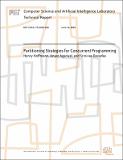| dc.description.abstract | This work presents four partitioning strategies, or patterns, useful for decomposing a serial application into multiple concurrently executing parts. These partitioning strategies augment the commonly used task and data parallel design patterns by recognizing that applications are spatiotemporal in nature. Therefore, data and instruction decomposition are further distinguished by whether the partitioning is done in the spatial or in temporal dimension. Thus, this work describes four decomposition strategies: spatial data partitioning (SDP), temporal data partitioning (TDP), spatial instruction partitioning (SIP), and temporal instruction partitioning (TIP), while cataloging the benefits and drawbacks of each. In addition, the practical use of these strategies is demonstrated through a case study in which they are applied to implement several different parallelizations of a multicore H.264 encoder for HD video. This case study illustrates both the application of the patterns and their effects on the performance of the encoder. | en_US |
